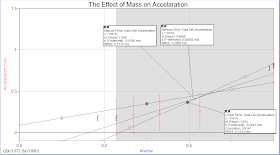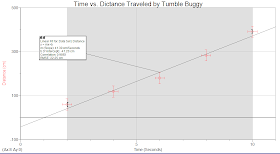Acceleration Lab
Does the mass of the car effect its acceleration? The independent variable will be the mass (g) of the car, and the resulting acceleration (m/s) of the car. The purpose of this experiment is to determine whether or not the mass of an object will effect the acceleration of the object. A low friction car, track, and pulley were used to greatly decrease the effect of friction on this experiment
The variables that were held constant are as follows: the incline of the track, units used for measuring, the car was started at the same point for each trail, the method of releasing the car, and the apparatus used (same car, track, masses, string, pulley, motion censor, and program used for analyzing the motion censor's data.) The incline of the track was held constant by placing the track on a flat surface, which kept the track horizontal (no incline.) The units of the masses remained in grams throughout the experiment, and the velocity was measured in meters per second for each trial. The car was started with the back end of it equal to the 25 cm marker on the track each time to ensure it had an equal distance in which to accelerate. When the car was released no additional force was added to the car- to achieve this release the finger that held the car at rest at it's initial position was simply lifted straight up and off the car, making certain to avoid moving in front of the motion censor. To further keep this method of release constant, the same experimenter released the car for each trail. Lastly, by using the same apparatus throughout each of the trails the car, track, masses, string, pulley, motion censor, and program used to analyze the motion censor's data remained constant.
The first IV level is the control group (490 g), in that no additional mass was added to the car. In the next four IV levels (690 g, 890 g, 1090 g, and 1290 g) 200 grams were added each time because it was believed that 200 grams would create a noticeable difference in acceleration without overloading the equipment with too much weight. The procedure was repeated for five trials at each IV level. By averaging the data from all of the trials, the a relatively reliable representation of the true acceleration be can found. Whereas, if only one measurement was taken the chance of error in that one point would be much higher.
The apparatus was assembled (as shown above) with a car resting on a low friction track, a paperclip is used to attach the string to the car, the string is then run through the low friction pulley, and a 50 gram mass was added to the end of the string so the string is pulled taught. A motion detector is added to the end of the track and then the motion detector is plugged into the computer so that the data from the motion censor can be read on the computer screen in Logger Pro. First, the "collect" button is pushed on logger pro in order the begin the collection of data. Second, the car is released from the 25 cm marker on the track (25 cm from the end of the track) without exerting any extra force on the car. Next, when the car reaches the end of the track, the "end" button in Logger Pro is pushed to stop the program from collecting data. Finally, the average slope of the velocity-time graph (for the time the car was accelerating) is taken in order to determine the average acceleration of the car.

The curve in the first graph implies that the graph may be an inverse equation. Assuming it's an inverse equation, the equation for the curve is: Acceleration (m/s)= 293.6 (+/- 48.77) / Mass (g.)
The second graph shows the linearized data, and the min and max lines.











